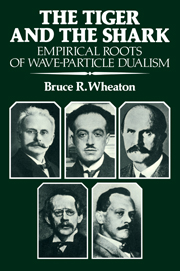Book contents
- Frontmatter
- Contents
- Foreword by Thomas S. Kuhn
- Preface
- Notes on sources
- 1 Introduction
- Part I The introduction of temporal discontinuity, 1896–1905
- Part II Ionization and the recognition of paradox, 1906–1910
- Part III Seeking an electrodynamic solution, 1907–1912
- Part IV Interference of x-rays and the corroboration of paradox, 1912–1922
- Part V The conceptual origins of wave–particle dualism, 1921–1925
- Epilogue: The tiger and the shark
- Bibliography
- Index
Foreword by Thomas S. Kuhn
Published online by Cambridge University Press: 04 August 2010
- Frontmatter
- Contents
- Foreword by Thomas S. Kuhn
- Preface
- Notes on sources
- 1 Introduction
- Part I The introduction of temporal discontinuity, 1896–1905
- Part II Ionization and the recognition of paradox, 1906–1910
- Part III Seeking an electrodynamic solution, 1907–1912
- Part IV Interference of x-rays and the corroboration of paradox, 1912–1922
- Part V The conceptual origins of wave–particle dualism, 1921–1925
- Epilogue: The tiger and the shark
- Bibliography
- Index
Summary
The first three decades of the twentieth century embraced two great changes in physical theory: relativity, both general and special, and quantum theory, both the old and the new. Among the innovations that constituted these theories, none was more difficult to accept and assimilate than Einstein's suggestion that light displays particulate properties, especially at high frequencies. Together with the related recognition of the wavelike properties of material particles, Einstein's light-particle theory has proved a fundamental constituent of modern physics, perhaps the single feature that most sharply distinguishes it from the generally Newtonian physics of the preceding three hundred years. But for nearly twenty years after Einstein's proposal in 1905, the concept of light-particles was almost everywhere rejected. Even R. A. Millikan, who in 1914–16 provided the first unequivocal evidence for Einstein's surprising law of photoelectric emission, continued, equally unequivocally, to disdain the light-particle hypothesis from which that law had been derived. Only after 1923, when Compton and Debye independently used the light-particle hypothesis to explain the shift in frequency of scattered x-rays, did more than a very few isolated physicists begin to take seriously the idea that electromagnetic radiation often behaves like particles.
That, in outline, is the way that historians of physics have recently been telling the story of the light-particle hypothesis, and with respect to Einstein it remains very nearly the way the story should be told. But, as Bruce R. Wheaton amply demonstrates in the pages that follow, Einstein's was only one approach to conceiving radiation as particulate.
- Type
- Chapter
- Information
- The Tiger and the SharkEmpirical Roots of Wave-Particle Dualism, pp. ix - xivPublisher: Cambridge University PressPrint publication year: 1983



